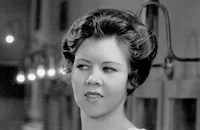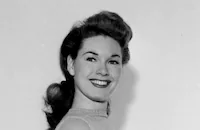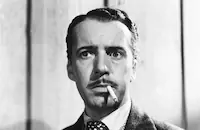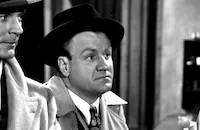They All Kissed the Bride

Brief Synopsis
Cast & Crew
Alexander Hall
Joan Crawford
Melvyn Douglas
Roland Young
Billie Burke
Allen Jenkins
Film Details
Technical Specs

Synopsis
Margaret J. Drew, known as "M. J." by her intimidated employees, has taken over command of the vast Drew financial empire from her late father. When reporter Michael Holmes begins to publish exposes about Drew's tyrannical employment practices, the imperious M. J. demands that he be investigated. Mike, who has gleaned his information from his friend, Drew driver Johnny Johnson, is driving with Johnny one day when they see a woman whose car has broken down along the road. When Johnny pulls over to help the woman, she identifies herself as a Drew spotter and cites him for carrying a passenger and stopping his vehicle. Furious about M. J.'s unjust policies, Mike decides to crash the wedding of her younger sister Vivian. At the Drew estate, meanwhile, Vivian's protests that she is in love with filling station attendant Joe Krim are met with a cold heart and deaf ears by M. J., who insists that she proceed with her marriage to Stephen Pettingill, the scion of a steel family. When M. J. steps outside and sees Mike, her knees buckle, an affliction that strikes the female members of the Drew family whenever they are confronted by a man to whom they are attracted. Dismissing her wobbly knees as a "liver ailment," M. J. mistakes Mike for a bodyguard hired to patrol the ceremony. After drinking too much brandy during the wedding, Mike becomes inebriated and amorous, and when he eagerly kisses Vivian, M. J. thinks that he must be Joe and decides to expose him as a fortune hunter. Summoning Mike to her room, M. J. hands him $1,000 in marked bills. Failing to recognize his nemesis, Mike kisses M. J., who then orders his arrest for blackmail. Upon discovering their error, M. J.'s attorney Marsh arranges Mike's release and warns her that the reporter could sue for false arrest. When Mike appears at her office to discuss the terms of an agreement, M. J.'s knees buckle and she excuses herself to visit the doctor. Becoming impatient, Mike gives his Brooklyn address to Marsh and instructs him to tell M. J. to meet him there that night. The doctor, meanwhile, prescribes sedatives to combat M.J.'s weak knees. That evening, M. J. goes to the Brooklyn address and is greeted by Johnny, Mike's neighbor, who has never met the head of Drew Enterprises and consequently mistakes M. J. for Mike's sweetheart. Before meeting Mike, M. J. swallows two pills, and soon after passes out. The next morning, M. J. is alarmed when she awakens in Mike's bed wearing his pajamas, but Mike assures her that Susie, Johnny's wife, put her to bed. Johnny then enters the room and provides Mike with more details about the company's injustices. Later that morning, M. J. surprises her employees when she strides into the office wearing the previous night's evening clothes. Vivian, who has returned early from her honeymoon, is waiting at the office to tell her sister that Steve was called back on business. As M. J. changes into her work clothes, Mike enters, addresses her as "Maggie," and offers to sign a release promising not to sue if she will have dinner with him. M. J. agrees, but after Mike signs the document, she conveniently remembers that she is busy, but then discovers that Mike has signed the release as "Benedict Arnold." That night, in a drenching rain storm, M. J. ventures to Brooklyn to keep her bargain with Mike, and Johnny tells her that Mike is at the Drew employees' dance and offers to drive her there. Along the way, Johnny is cited by one of the Drew company spies for carrying a passenger. At the dance, M. J. finds Mike and asks to keep her dinner date with him. When the dance contest is announced, however, Johnny grabs M. J. as his partner and begins wildly jitterbugging with her. Crane, the head of Drew personnel, is shocked to see his boss on the dance floor and awards her first prize. After the dance, Mike, M. J., Susie and Johnny return to the apartment and get drunk. When Johnny insists upon driving the inebriated M. J. home, they all pile into the truck, and Mike climbs into the driver's seat and kisses M. J. After pulling into the Drew driveway, Mike escorts M. J. into her house while the watchman informs the astonished Johnny that his friend Maggie is really M. J. Drew. When M. J. tries to seduce Mike, he resists and then passes out. At the office the next morning, M. J. learns from Crane that Johnny and eleven other drivers have been fired for taking their trucks to the dance, and Crane listens in disbelief when M. J. orders them rehired and granted a five dollar raise. Back at the house, meanwhile, Mike awakens wearing the cook's nightgown and is relieved to discover that the butler put him to bed. Soon after, Johnny barges into the bedroom and blames Mike for the drivers' firing. Mrs. Drew, M. J.'s addle-brained mother, then enters and asks Mike to lend Steve $30,000 so that he can reopen his family's steel mill and bid on a defense contract. After extracting a promise from Steve that he will hire all the drivers, Mike agrees to the loan and proceeds to M. J.'s office, where he offers to sign the release in exchange for $30,000. Feeling betrayed, M. J. accepts his terms and then attends a business meeting. Unable to keep her mind on her speech, M. J. finds her thoughts interrupted by images of blissful domesticity and after adjourning the meeting, she hurries to see the doctor, who diagnoses her as being lovesick. Returning home to chair a stockholders' meeting, M. J. is confronted by her mother, who tells her that Mike gave Steve the $30,000 to hire the drivers. Finally realizing that she is in love with Mike, M. J. hurries to Brooklyn but Johnny and the other drivers refuse to let her see him. Susie then arrives and tells M. J. that Mike is waiting for Johnny to pick him up. Soon after, Johnny meets Mike and instructs him to climb in the back of the truck and close the door. When one of the Drew spies spots the truck, M. J. opens the doors and tells Johnny to drive to the nearest minister.

Director

Alexander Hall
Cast

Joan Crawford

Melvyn Douglas

Roland Young

Billie Burke

Allen Jenkins
Andrew Tombes

Helen Parrish
Emory Parnell

Mary Treen
Nydia Westman

Ivan Simpson
Roger Clark
Edward Gargan

Gordon Jones

Larry Parks
Tom Dugan
Charles Miller
George Pembroke
Wyndham Standing

Shirley Patterson
Douglas Wood

Boyd Irwin
Frank Dawson

Ann Doran

Alma Carroll
Charles Coleman
Ralph Sanford
Father Neal Dodd

Ralph Dunn
Wheaton Chambers
Arthur Stuart Hall
Richard Kipling
Hal Cooke
John Merkyl
Dale Van Sickel
Polly Bailey
Walter Merrill
Terrance Ray
Harry Strang
Charles Sullivan
Frank Marlowe
Ernie Adams

Lyle Latell
Ralph Peters
Tom Lincir
Rosalie Miller

George Mckay
William Edmunds
Kitty Kelly

Charles Lane
Norman Willis

Charles Halton
John Dilson
Crew
Henry Altimus
Lionel Banks
George Cooper
Werner R. Heymann
Irene
Edward Kaufman
Gina Kaus
Viola Lawrence
Johnny Mercer
William Mull
Cary Odell
Andrew P. Solt
Andrew P. Solt
M. W. Stoloff
Joseph Walker
Harry Warren
P. J. Wolfson

Photo Collections
Videos
Movie Clip


Film Details
Technical Specs

Articles
They All Kissed the Bride
The film had never actually been planned for Crawford. It was meant as Carole Lombard's follow-up vehicle after To Be or Not to Be (1941). When she died tragically in a 1942 plane crash on her way back from a bond-selling tour, Louis B. Mayer at MGM agreed to let Crawford take her place on loan to Columbia, where producer Edward Kaufman put P.J. Wolfson to work re-writing the script to fit her. The loan was a rare occurrence for Mayer. He rarely lent out stars of Crawford's stature, not wanting other studios to profit from MGM's star-making machine, arguably the best in the business. Moreover, the loan would mean teaming Crawford with Melvyn Douglas, with whom she had appeared in one of her biggest flops, The Shining Hour (1938), and whose liberal politics Mayer despised.
Despite the circumstances, however, Crawford had to be excited about the chance to try something different. Having been less than pleased with recent assignments at MGM, where she had to fight for her best pictures, she knew that Mayer's mismanagement of her career was costing her at the box office. Moreover, with the plum roles at MGM going first to Norma Shearer and now to Greer Garson, she needed a hit to re-kindle her fading popularity. Of course, like all of Hollywood, she had been terribly shaken by the highly popular Lombard's death. In her honor, she agreed to donate her salary for They All Kissed the Bride to charity. When her agent demanded his commission nonetheless, she paid it, then fired him.
One big bonus Crawford got out of They All Kissed the Bride was the chance to work with Irene, one of Hollywood's and the fashion world's top designers, who had helped popularize turbans with her work on Algiers (1938) and put Marlene Dietrich in Navy whites in Seven Sinners (1940). Her chic designs would showcase the star at her most glamorously feminine. In fact, she would follow Crawford back to MGM for her next film, Reunion in France (1942), and stay with the studio through her departure from Hollywood in 1950. (She returned briefly to work on two Doris Day films in the early sixties before committing suicide in 1962).
For Crawford, the film pointed to one of her biggest future successes. Although she had enjoyed a run of rags-to-riches stores depicting her as a typical working woman, she had never played a driven career woman like M.J. Drew in this film, a part that would have seemed more suited to Rosalind Russell. Of course, she would score one of her biggest hits as the head of a restaurant chain in Mildred Pierce (1945), the film that would finally bring her an Oscar® for Best Actress. And she would return to career woman roles as a congresswoman in Goodbye, My Fancy (1951), a playwright in Sudden Fear (1952) and a publishing executive in The Best of Everything (1959).
They All Kissed the Bride was also very much a product of its time. In these days of celebrity rehab and interventions as weekly series, the use of alcohol and drugs as a convenient excuse for putting the romantic leads in compromising situations seems a relic from earlier times. At least one remnant of the film's earlier era is usually cut for contemporary audiences. During its initial release, the picture's biggest laugh came when, disgusted with Douglas' poking around in her affairs, Crawford snaps, "When I want a sneak, I'll hire the best and get a Jap." In the months after the Pearl Harbor attack, audiences were primed for any insult leveled against the enemy. Today, however, the line is deemed offensive and usually cut from television airings.
They All Kissed the Bride received positive reviews, with Variety suggesting the risqué but still tasteful jokes would help the film catch audience interest. That wasn't enough to stem Crawford's downward slide at the box office, particularly with the lackluster films Mayer had waiting for her on her return to MGM. It would take years of television airings, revival screenings and availability on home video to help Crawford's fans discover one of the forgotten gems of her career.
Producer: Edward Kaufman
Director: Alexander Hall
Screenplay: Andrew Solt, P.J. Wolfson, Henry Altimus
Based on a story by Solt and Gina Kaus
Cinematography: Joseph Walker
Art Direction: Lionel Banks, Cary Odell
Music: Warner R. Heymann
Cast: Joan Crawford (Margaret J. 'M.J.' Drew), Melvyn Douglas (Michael Holmes), Roland Young (Marsh), Billie Burke (Mrs. Drew), Allen Jenkins (Johnny Johnson), Helen Parrish (Vivian Drew), Mary Treen (Susie Johnson), Nydia Westman (Lewis - M.J.'s Secretary), Ann Doran (Helene - the Drews' Maid). Charles Lane (Spotter), Larry Parks (Joe Krim).
BW-85m.
by Frank Miller

They All Kissed the Bride
Quotes
When I want a sneak, I'll hire the best and get a Jap.- Margaret Drew
Trivia
'Lombard, Carole' was originally cast in this film, but due to her death in a plane crash in January, 1942, Joan Crawford replaced her. When the film was completed, Miss Crawford contributed her entire salary to the American Red Cross in the name of Carole Lombard.
Notes
The working title of this film was He Kissed the Bride. Hollywood Reporter news items yield the following information about this production: Richard Flournoy was originally assigned to write the screenplay, which was to have been a vehicle for Melvyn Douglas and Carole Lombard. After Lombard perished in a plane crash on January 16, 1942 while returning from a war bond rally, P. J. Wolfson was hired to rewrite the script to suit Joan Crawford. The film's end credits acknowledge that "Miss Crawford appears through the courtesy of Metro-Goldwyn-Mayer." According to the Variety review, Crawford donated her salary for the film to various charities, in memory of Lombard. According to a Hollywood Reporter news item, cinematographer Joseph Walker used a special lavender lighting technique on Crawford to enhance the brilliance of her eyes. This was former Twentieth Century-Fox producer Edward Kaufman's first and only production for Columbia. Helen Parrish was borrowed from Universal to appear in the picture. According to the Variety review, Crawford spoke the following line of dialogue: "When I want a sneak, I'll hire the best and get a Jap." The line was not in the viewed print.

Miscellaneous Notes
Released in United States 1942
Re-released in United States on Video February 11, 1997
Released in United States 1942
Re-released in United States on Video February 11, 1997













